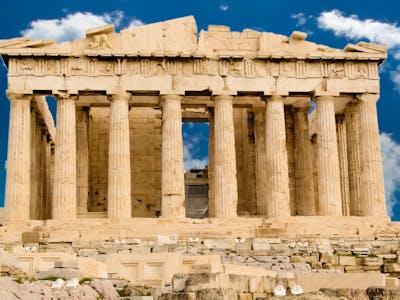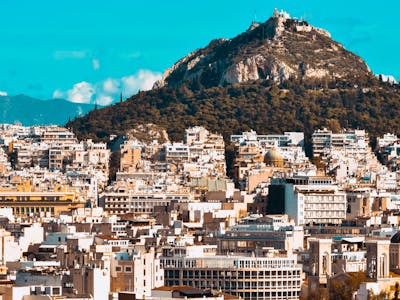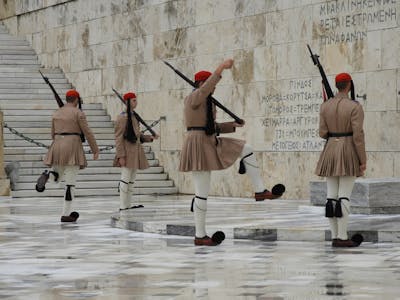The Temple of Olympian Zeus, also known as the Olympieion, was built between 174 and 132 BC in Athens. It was one of the largest temples ever built in the ancient world, measuring 115 by 110 meters, and was dedicated to Zeus, the king of the gods in Greek mythology. The massive structure was one of the most impressive buildings in ancient Athens and was a symbol of the city's power and wealth.
In 267 AD, the Heruli attacked and Athens and the temple was destroyed, presumably never to be repaired again. The ruins of the temple were excavated in the 19th century and the site is now a popular tourist attraction in Athens.
Temple of Olympian Zeus - In a Nutshell
Temple of Olympian Zeus - Things to know
| 📍 Location: | Athens |
| ⏰ Suggested Duration: | 2 Hours |
| ☀️ Best Time to Visit: | Early morning |
| 🎟️ Temple of Olympian Zeus Tickets: | €13 |
| 🚇 Closest Subway: | Acropolis |
Temple of Olympian Zeus Opening Hours
• November to March - 8 AM to 3.30 PM
• April to October - 8 AM to 7 PM
Must-see at the Temple of Olympian Zeus
The Gate of Hadrian
The Themistoclean Wall
Doric Temple of Apollo Delphinos
Temple of Kronos and Rhea
Temple of Olympian Zeus Address
Athens 105 57, Greece Get Directions
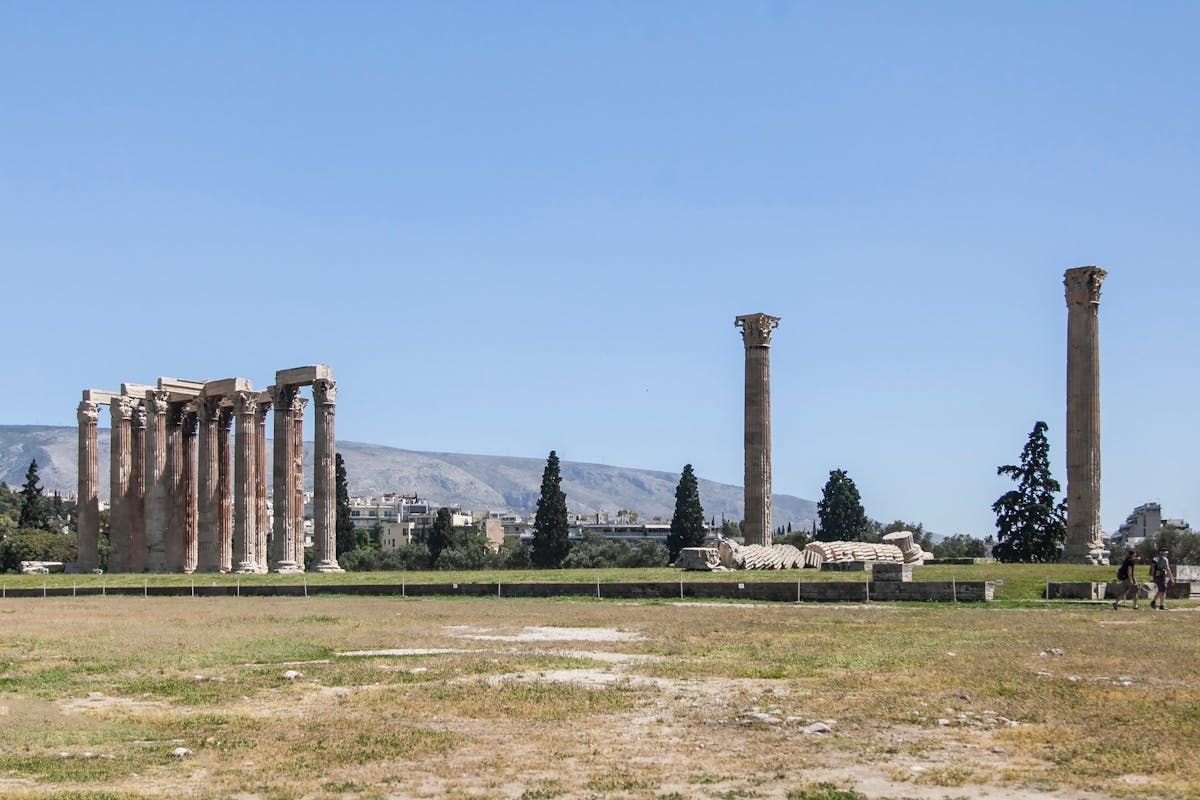
Recommended tickets for Temple of Olympian Zeus
Best time to visit the Temple of Olympian Zeus Athens
It is best to visit the temple during the summer months, when the weather is warm and sunny. However, the temple is also open during the winter months, so visitors can still enjoy the spectacular ruins; if they're lucky, under a dusting of snow!
Despite the crowds in the summer, the grounds of the site are expansive, so it will still make be easy for you to take in the magnificence of the ruins at your own pace.
You can read more about the weather in Athens to make an informed decision about your trip in our guide to the Best Time to Visit Athens
Why Visit the Temple of Olympian Zeus Athens
The Temple of Olympian Zeus is one of the most popular tourist attractions in Athens. The temple is a great example of ancient Greek architecture and is one of the largest temples ever built in Greece and a reminder of the power and influence of the Greek gods in the ancient world.
History
The temple was built in the 6th century BCE, and was one of the largest temples in Greece. The columns were made of marble, and were each over 20 meters tall. It was destroyed by the Romans in the 2nd century CE, and the columns were later used to build the Hadrian's Library. It remains a popular tourist destination in Athens.
The temple was built over a period of more than 600 years, from the 6th century BC to the 2nd century AD. It was the largest temple in Athens and one of the largest in the ancient world.
The columns of the temple are made of marble and are 6m (20ft) in diameter. They are some of the largest columns ever erected. The height of the column from the ground to the top is 18m (59ft). There were 104 columns in total, arranged in 16 rows of 8 columns each. The temple was damaged by earthquakes over the centuries and was finally abandoned in the 5th century AD. It was later used as a quarry, and many of the columns were taken away to be used in other buildings.
Today, only 15 of the original 104 columns remain standing. The temple is a popular tourist attraction in Athens. was later used as a quarry for building materials.
Sites to See at the Temple Olympian Zeus Athens
1The Gate of Hadrian
The Gate of Hadrian, also known as the Arch of Hadrian, is a monumental gateway lying to the east of the Acropolis in Athens. It was built in 132 AD by Roman Emperor Hadrian in order to mark the boundary between the city and its easternmost territory. The arch is made of Pentelic marble and stands on a base of three steps. It is decorated with reliefs depicting Roman soldiers, and has two inscriptions bearing Hadrian's name.
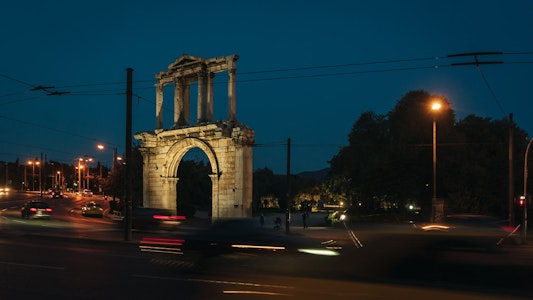
2The Themistoclean Wall
When the Themistoclean Wall was constructed in 479 BCE, it ran for 10 miles from the Lycabettus Hill to the Phaleron Bay. The wall was built to protect Athens from invasions from the north and consisted of three courses of large stone blocks. The wall was named after its architect, Themistocles, who also oversaw the construction of the Athenian Navy that helped defeat the Persians at the Battle of Salamis in 480 BCE. The wall continued to protect Athens until it was breached by the Spartans in 404 BCE during the Peloponnesian War.
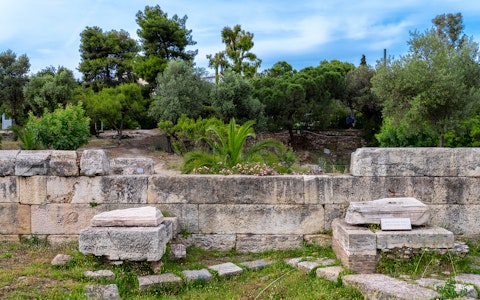
3Doric Temple of Apollo Delphinos
The Doric Temple of Apollo Delphinium was built in the late 6th century BC. It is located in the northwestern part of the Athenian Acropolis, on a terrace overlooking the Ancient Agora. The temple was dedicated to Apollo, the god of music and healing. It was one of the most important temples in Athens, and served as a place of healing for the sick and injured. The temple was also used as a place of refuge during times of war. It was built using local marble from Mount Pentelicus. The exterior of the temple was decorated with reliefs depicting scenes from Greek mythology.
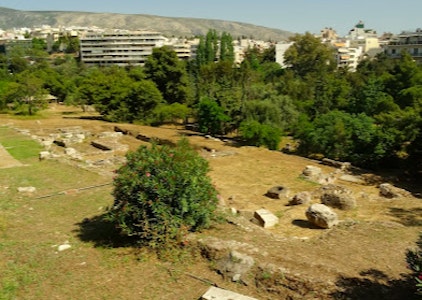
4Temple of Kronos and Rhea
Not much is left of this temple. There are stumps remaining of the pillars, still in the ground, under a small group of trees. While nothing as grand as the temple itself, it is one of the many sites that dots the premises of the temple. It's a temple dedicated to the elder gods, parents of Zeus, Kronos and Rhea.
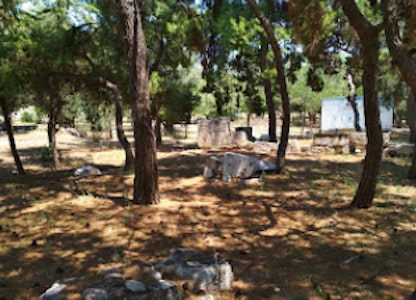
The Temple of Olympian Zeus Athens Tickets
On-site
The Temple of Olympian Zeus is quite a popular tourist attraction. This makes it hard to get tickets at the counter. However, if you want to try your luck, you can head to the ticket office and purchase the tickets.
Buy Them Online
The best option is to get your timed Temple of Olympian Zeus tickets online since you need not worry about being denied entry. You also have the option of choosing Temple of Olympoan Zeus tickets with a mobile audio guide, if you want to explore the site solo. Booking them online also gives you the perks of discounts and cashback, saving you time & money.
Temple of Olympian Zeus Facts
- The temple took nearly 600 years to complete, but was fully functional only for hundred years before being destroyed in an invasion.
- During the Roman period, it was the largest temple in Greece with 104 colossal marble columns.
- Hadrian's Arch, near the temple, was considered to be the gateway to the Acropolis in the ancient times.
- After it's destructions, barely any attempts were made to restore it. In fact, during the medieval period, the stone from the temple ruins was quarried to build churches and houses in the area.
Visiting the Temple of Olympian Zeus Athens
Getting There
By Bus: The closest bus stop is Akropolē, which is only 250 meters from the ticket office.
By Metro: The nearest subway station is Acropoli and is at a walkable distance from the Temple of Olympian Zeus.
By Car: Take the road to Ροβέρτου Γκάλλι 5 and drive straight onto Rovertou Galli 39 road. Turn right to enter Dionysiou Areopagitou road. The ticket office is at the end of the road.
Restaurants Near The Acropolis Of Athens
Insider Tips for your Temple of Olympian Zeus Visit
Hot Tip: Highly recommended that you get the Ancient Athens Pass! It allows you to skip the lines at the Acropolis, the Temple of Zeus, as well as the Agora of Athens, all of which are located within a walking distance of the temple.
- You can cover the Acropolis, the Agora and the temple on the same day; they're all within walking distance of each other.
- Keep in mind that the sprawling lawn around the temple is generally not meant for the crowds to sit on. Security guards will likely come up to warn you against it. There are benches in the shade for you to sit on if you find yourself tired.
- There are tiny sites scattered across the perimeter of the temple's premises. Make sure to check them out too!
- If you're planning to head to the temple after a visit to the Acropolis, make sure to carry plenty of water with you; especially if you plan to journey on foot.
Things to do Nearby
FAQs
What happened to the Temple of Olympian Zeus?
Is the Temple of Olympian Zeus in Olympia?
Is the Temple of Olympian Zeus still standing?
Is there a fee to enter the Temple of Olympian Zeus?
What is Zeus' name in Greek?






